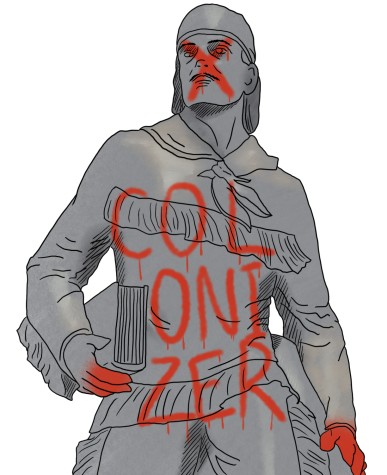OP-ED: Rinse and repeat?
October 9, 2019
The Marcus Whitman statue is at it again, sparking activism that compels us to confront Whitman College and white settlement as one and the same.
This time, the statue’s defacement involved rephrasing “My Plans Require Time and Distance” (a quote attributed to Whitman himself) to “My Plans Require Time and Genocide.” The bloodied hand made a reappearance, with the red paint riding up on the oversized bible held by the frontiersman. Later, the statue sported a spray painted face in copper; a new twist that perhaps references lines from the 1819 Percy Shelley poem, The Mask of Anarchy, a version of which was spray painted onto an adjacent building: “Rise like Lions from your slumber in unvanquishable number/Shake off your chains which like dew in your sleep fell on you/Ye are many; they are few.”
As of this writing, the statue has been cleaned – twice. The building, partially so. Words from a Maya Angelou poem are currently written across its semi-washed surface. They read: “But Still Like Dust, I’ll Rise.” It will not likely be there tomorrow.
It is time to break this cycle of rinse and repeat. If the option of leaving a defaced Whitman monument defaced is off the table, given concerns about its potential to incite more property damage (an administrative reasoning that I have argued against), then the College should find another way to make space for public expressions of a changing and variably lived campus-community. Here are four ideas that have been percolating around campus since at least 2017, in order of ambition:
- Remove the statue with zero fanfare. Xerioscape the remaining site.
- Re-curate the statue with multiple plaques that present the history of Whitman’s role in colonizing the region, the history of the aesthetic choices made by the artist and the history of the statue’s presence on campus. Include a version of this text for all campus tours. Invite members of the Confederated Tribes of the Umatilla Indian Reservation (CTUIR) to collaborate in the writing. Build curriculum around this project.
- Let the statue stand and hold a public design competition for a contemporary artistic response to it, with intentions and funds to fabricate and install the winning design. Populate the jury with other artists, willing members of the CTUIR, Whitman students, faculty and staff. Use design competitions that are reimagining Confederate monuments and memorials as a guide. Build curriculum around this project.
- Let the statue stand and commission a work of site-specific art from a high-profile indigenous artist with ties to this region and a capacity to interact with the piece on multiple levels. Pair the commission with arts-focused scholarships for indigenous students. Use the commission and the scholarships as an occasion to raise Whitman’s own profile as a distinguished liberal arts institution in the West with an inclusive future. Build curriculum around this project.
Any variation of these proposals will increase the strides made in renaming our campus newspaper and mascot as well as in the outstanding exhibition, A Proper Monument, of last year. It will also institutionalize the commitment to address Whitman’s colonial past and present. That commitment was made through the College’s 2017 memorandum of understanding with the CTUIR, an agreement that President Murray said would enable Whitman “to engage across difference and to understand each other and each other’s ways and histories better than we have in the past.” How many more defacements and cleanings will it take before we calibrate a larger-than-life bronze and marble missionary to this mission?
Lisa Uddin
Associate Professor and Paul Garrett Fellow





